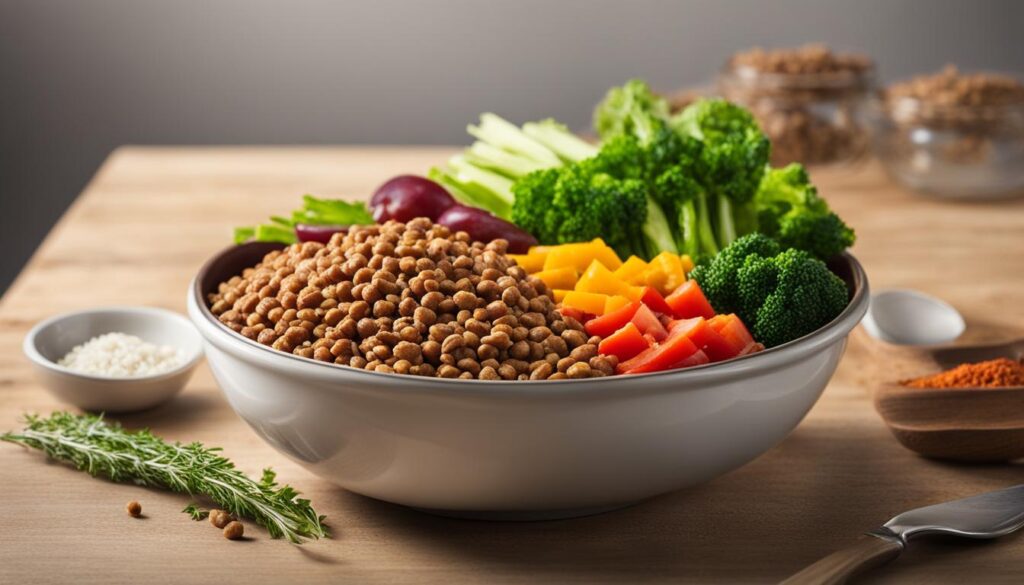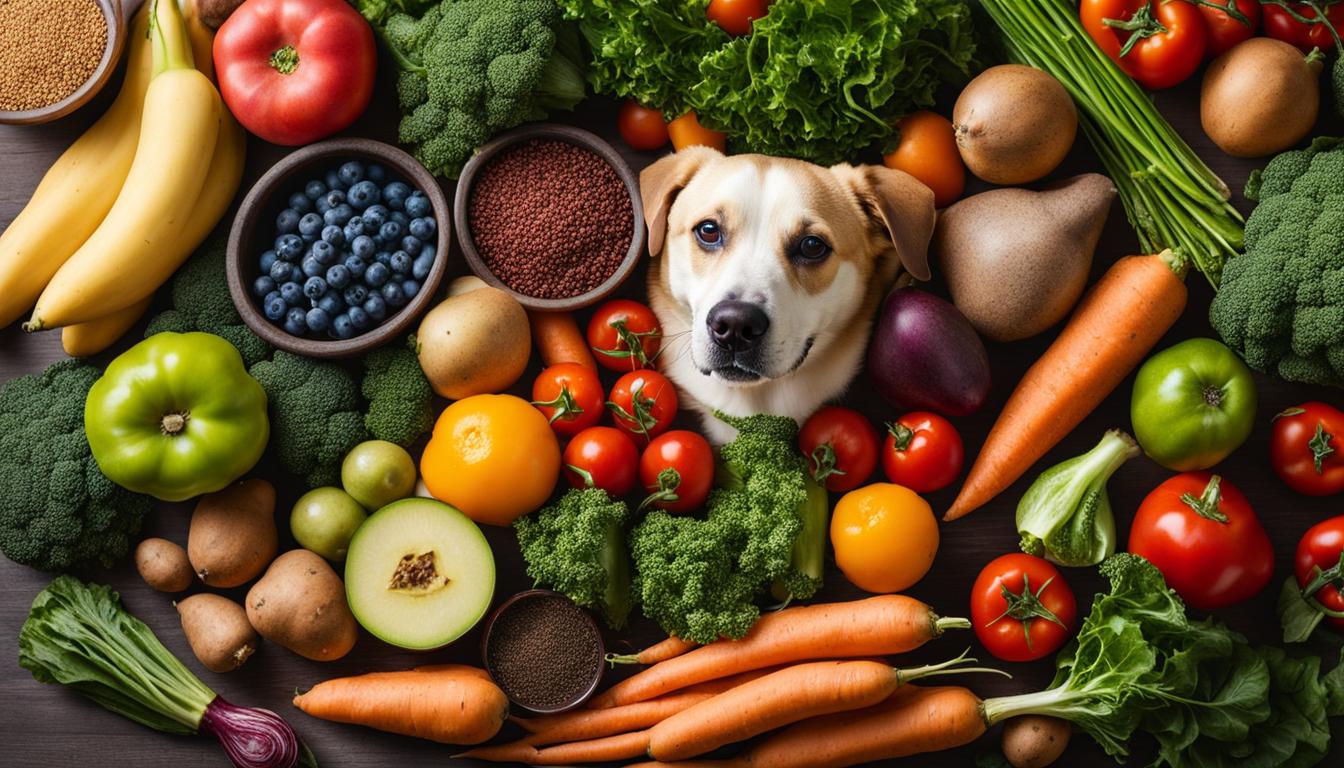Considering a raw food diet for your furry friend? Before you make a decision, it’s important to understand the pros and cons of feeding your dog raw food. Advocates claim that it closely mimics a dog’s ancestral diet and offers numerous benefits such as nutrient preservation, improved dental health, and enhanced digestion. However, there are also potential drawbacks to be aware of, including bacterial contamination and the risk of nutritional imbalance. In this article, we’ll delve into the details and help you make an informed choice for your dog’s nutrition.
Key Takeaways:
- Raw dog food can provide nutrient preservation, dental health benefits, and improved digestion.
- However, there are risks of bacterial contamination and nutritional imbalance associated with raw dog food.
- Cooked dog food can offer improved digestibility and reduced bacterial risk, but may result in nutrient loss and oxidative damage.
- Considering Traditional Chinese Veterinary Medicine (TCVM) perspective can help in creating a customized diet plan based on your dog’s specific needs.
- Ultimately, choosing the right diet requires careful consideration, guidance from professionals, and regular monitoring of your dog’s health.
The Benefits of Raw Dog Food
Raw dog food has gained popularity among pet owners who believe it provides several benefits for their furry friends. Let’s take a closer look at some of the advantages of feeding your dog a raw food diet.
Nutrient Preservation
One of the main arguments in favor of raw dog food is its ability to preserve the natural nutrients found in ingredients. Raw food is minimally processed and not subjected to high heat, which can degrade fragile vitamins and enzymes. The enzymes present in raw food can aid in digestion and nutrient absorption, ensuring that your dog receives maximum nutritional benefits.
Dental Health
Feeding your dog raw food can also promote dental health. Chewing on raw bones and tougher cuts of meat provides natural dental stimulation, helping to reduce plaque and tartar buildup. The mechanical action of gnawing on bones can help keep your dog’s teeth clean and healthy.
Improved Digestion
Raw diets are often higher in moisture content and naturally occurring enzymes, both of which can contribute to improved digestion in dogs. The higher moisture content can prevent dehydration and promote regular bowel movements. Additionally, the live enzymes present in raw food can aid in breaking down proteins and carbohydrates, making digestion easier on your furry friend’s digestive system.
Overall, raw dog food can provide various benefits, including nutrient preservation, dental health, and improved digestion. However, it’s important to weigh these advantages against the potential drawbacks and consider your dog’s individual needs and health conditions before making any dietary changes.
| Benefits of Raw Dog Food |
|---|
| Nutrient Preservation |
| Dental Health |
| Improved Digestion |
Drawbacks of Raw Dog Food
While raw dog food has gained popularity among pet owners, it is important to be aware of the potential drawbacks associated with this type of diet. Understanding these drawbacks will help you make an informed decision about whether raw dog food is the right choice for your furry friend.
Bacterial Contamination
One of the main concerns with raw dog food is the risk of bacterial contamination, such as Salmonella or E. coli. Raw food can carry these harmful bacteria, which can not only make your dog sick but also pose a risk to you and your family, especially if proper food handling and hygiene practices are not followed. It is essential to be diligent in handling raw dog food and to practice good hygiene to reduce the risk of bacterial contamination.
Nutritional Imbalance
Preparing your own raw dog food requires careful planning and knowledge about a dog’s nutritional requirements. Without a proper understanding of these needs, there is a risk of creating an imbalanced diet that may lead to nutrient deficiencies or excesses. It is crucial to consult with a veterinary nutritionist or canine nutrition expert to ensure that your dog’s raw diet is nutritionally balanced and meets their specific needs.
Nutrient Availability
While raw dog food is often praised for its high nutrient content, it’s important to consider that certain nutrients may become more bioavailable through the cooking process. Cooking food for dogs can enhance nutrient availability and digestibility, making it easier for your dog to absorb the essential nutrients they need. In some cases, cooking food can provide a more balanced and easily digestible diet for your dog.
| Drawback | Description |
|---|---|
| Bacterial Contamination | Raw dog food poses a higher risk of bacterial contamination, such as Salmonella or E. coli, for both dogs and humans handling the food. |
| Nutritional Imbalance | Preparing your own raw dog food may lead to an imbalanced diet if you are not knowledgeable about a dog’s nutritional requirements. |
| Nutrient Availability | Cooking dog food can enhance nutrient availability, making it easier for your dog to absorb essential nutrients. |
Considering these drawbacks, it is important to weigh the potential benefits and risks before deciding whether to feed your dog a raw food diet. If you do choose to feed raw, take necessary precautions to minimize the risk of bacterial contamination, consult with a professional to ensure a nutritionally balanced diet, and consider the alternative of cooking dog food to enhance nutrient availability and digestibility.
The Pros and Cons of Cooked Dog Food
When it comes to feeding your furry friend, cooked dog food offers both benefits and drawbacks to consider. Let’s take a closer look at the various factors involved:
Improved Digestibility
Cooking food for dogs can enhance the digestibility of their meals. The cooking process breaks down complex proteins and carbohydrates, making it easier for your dog’s body to absorb and utilize the nutrients. This can be especially beneficial for senior dogs or those with compromised digestion.
Reduced Bacterial Risk
One of the advantages of feeding your dog cooked food is the reduced risk of bacterial contamination. Appropriate cooking temperatures can eliminate harmful bacteria such as Salmonella or E. coli, ensuring your pup’s safety. This is particularly important if you have young children or other vulnerable individuals in your household.
Loss of Nutrients
However, cooking dog food can lead to some nutrient loss. Heat-sensitive vitamins and enzymes may break down during the cooking process, diminishing their availability. To mitigate this, you can incorporate nutrient-rich supplements or choose cooking methods that preserve more of these delicate nutrients, such as steaming or lightly baking.
Oxidative Damage and Dental Health
High-temperature cooking methods like frying or grilling can produce harmful compounds that contribute to oxidative stress and inflammation. It’s essential to strike a balance between properly cooked food and the potential negative effects of overcooking. Additionally, unlike raw diets, cooked food may not offer the same dental health benefits, as the process of chewing on raw bones and tougher cuts of meat is absent.
In summary, cooked dog food provides improved digestibility, reduced bacterial risk, and the ability to customize nutrient profiles. However, it may lead to some nutrient loss and lacks the dental health benefits of raw food. It’s important to find the right balance for your furry friend’s dietary needs, considering factors such as their age, health conditions, and personal preferences.

Traditional Chinese Veterinary Medicine Perspective
In Traditional Chinese Veterinary Medicine (TCVM), the concept of Yin and Yang plays a crucial role in determining a dog’s optimal diet. Yin and Yang are opposing forces that need to be balanced to maintain harmony and promote health. Yin is associated with cooling and nourishing properties, while Yang represents warmth and energy. When it comes to feeding dogs, TCVM practitioners believe that a customized diet plan based on a dog’s specific Yin and Yang needs can support overall well-being.
Creating a customized diet plan in line with TCVM principles involves considering factors such as a dog’s age, breed, and specific health conditions. Holistic veterinarians or canine nutritionists experienced in TCVM can provide expert guidance in formulating a balanced diet that aligns with your dog’s unique needs. By tailoring the diet to enhance Yin or Yang properties, TCVM aims to address specific health concerns and optimize your dog’s overall health.
TCVM recognizes that every dog is different, and finding the right dietary approach may require some trial and error. Regular monitoring of your dog’s health is crucial, as it helps determine if any adjustments to the diet are necessary. Consulting with professionals who understand the principles of TCVM can empower you to make well-informed decisions about your dog’s nutrition and promote their overall well-being.
Example of a Customized Diet Plan
“Based on TCVM principles, a customized diet plan for a dog with a Yin deficiency may include cooling ingredients such as fish, duck, or tofu, along with fruits and vegetables like watermelon, cucumber, and spinach. On the other hand, for a dog with a Yang deficiency, warming foods such as lamb, beef, or chicken can be included, along with ingredients like ginger, sweet potato, and carrots. The goal is to restore the balance of Yin and Yang in the dog’s body through their diet.”
| Yin | Yang |
|---|---|
| Foods that cool the body | Foods that warm the body |
| Fish | Lamb |
| Duck | Beef |
| Tofu | Chicken |
| Watermelon | Ginger |
| Cucumber | Sweet Potato |
| Spinach | Carrots |

Conclusion
So, you’re at the final stage of making a decision about your dog’s diet – raw or cooked? Well, it’s not an easy choice to make, but fear not! We’ve covered all the pros and cons of both options to help you weigh your options.
First and foremost, regardless of the diet you choose, the key is ensuring a balanced and nutritious meal for your furry friend. Whether it’s raw or cooked, it’s crucial to provide all the essential nutrients your dog needs to thrive.
Regular monitoring is essential, as each dog is unique and may have specific dietary requirements. Keep an eye on their health and make adjustments as needed. Veterinary nutritionists can provide expert guidance and help you fine-tune your dog’s diet as they grow and change.
Remember, there’s no one-size-fits-all answer when it comes to raw or cooked food for your dog. It ultimately depends on your dog’s health, individual needs, and your ability to handle and prepare the food safely. So, gather all the information, consult with professionals, and embark on this culinary adventure to give your furry companion the best diet possible!
FAQ
What are the benefits of raw dog food?
Proponents of raw dog food argue that it closely resembles a dog’s ancestral diet and can provide benefits such as nutrient preservation, dental health, and improved digestion.
What are the drawbacks of raw dog food?
Potential drawbacks of raw dog food include bacterial contamination and the risk of nutritional imbalance.
How does cooking food for dogs impact nutrient availability?
Cooking food for dogs can improve digestibility and reduce the risk of bacterial contamination, but may also lead to nutrient loss and oxidative damage.
What are the potential benefits of cooked dog food?
Cooking food for dogs can enhance nutrient availability and absorption, making it beneficial for senior dogs or those with compromised digestion. It also reduces the risk of bacterial contamination.
What are the potential drawbacks of cooked dog food?
Cooked food may lead to nutrient loss, particularly heat-sensitive vitamins and enzymes. High-temperature cooking methods like frying or grilling can produce harmful compounds that contribute to oxidative stress and inflammation. Cooked food may not provide the same dental health benefits as raw food.
What is the perspective of Traditional Chinese Veterinary Medicine?
According to Traditional Chinese Veterinary Medicine (TCVM), raw food is considered cooling and yin in nature, while cooked food is warming and yang. Balancing yin and yang in a dog’s diet is important, and customized diet plans can be created based on a dog’s specific needs.
How should I choose between a raw food or cooked food diet for my dog?
Choosing between a raw food or cooked food diet for your dog requires careful consideration and depends on factors such as your dog’s health, individual needs, and your ability to handle and prepare the food safely. It is crucial to ensure a nutritionally balanced diet and seek guidance from professionals, such as veterinary nutritionists.
What is the importance of regular monitoring in a dog’s diet?
Regular monitoring of your dog’s health and adjusting their diet accordingly is essential in finding the right dietary approach. Every dog is unique, and the right diet may involve trial and error to ensure their optimal health and well-being.





